How To Use Video In Marketing And Sales To Drive Revenue Growth
- Home
- How To Use Video In Marketing And Sales To Drive Revenue Growth
This is a transcript of a talk from HubSpot at the HubSpot User Group Meeting in June 2019 in London.
I thought it was a great morning and I'm going to make the next 30 to 40 minutes as engaging as possible to talk to you guys about this wonderful world of video marketing and sales. What we were talking about is that video is becoming this amazing way to be helpful, to be human and to build trust with buyers.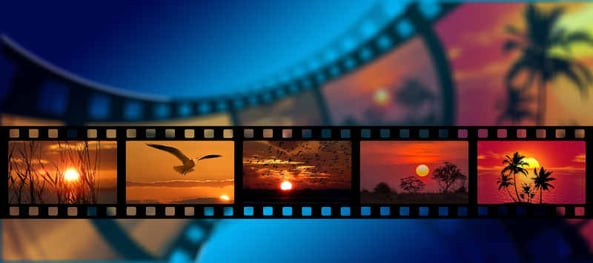
People are reading less and they're watching more. They’re trusting less in businesses and therefore we need to change the way in which we communicate, we present ourselves and engage them in content experiences. I'm going to talk over the next little bit, to give you guys really practical ideas about how businesses today are starting to use video and where we see it going over the next 1 to 5 years. I think what's really exciting about what's happening here, is to the point that it's going beyond the top of funnel, beginning of flywheel marketing and going all throughout that customer experience. I want to make sure all of you walk away today with ideas and the tools to just get going with video because most people love the idea but they struggle with getting going.
“Don't feel guilty about it because psychologically we are drawn to video as a medium”
You're going to walk away with some very specific ideas here. I'm going to start with the fact that video is such an important piece today because inherently we all know people love video. They love to consume video content for a number of different reasons.
- 75% of all internet traffic is now video content
That number is going to exceed 82% within the coming years and just continue to grow. More and more of you go home and you're watching Game of Thrones or whatever it is, the new black mirror season, don't spoil it! Whatever it is you do, don't feel guilty about it because psychologically we are drawn to video as a medium, so if anybody gives you a hard time for watching too much video and too much TV, just let them know there's millions of years of psychology behind it.
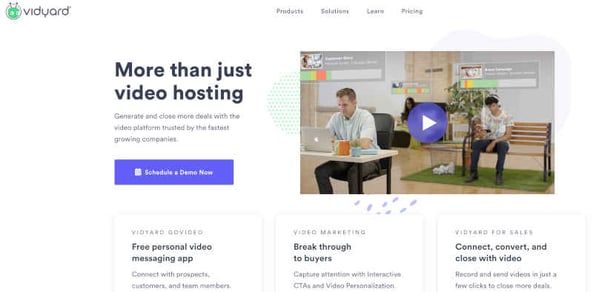
I think the really interesting part of video is that as a middle stat buyers trust a brand more and they're more confident making a buying decision when they interact with video content. A lot of this is about understanding the why behind businesses and the people, but also being able to see transparently. If you're a product company, being able to see what you do in reality as opposed to just reading about it or hearing about it. These are some of the things that we're seeing businesses adopt more and more. Finally, what gets me most excited right now is, the evolution of video into:
- Sales
- Customer service
which is a different way to:
- engage our buyers,
- to build trust,
- drive more engagement,
- bring the humanity back to sales and service
which I think is a really important part of what we need to talk about today.
A lot of us, including myself, I'm a marketing leader and feel we've swung too much on the digital one to many scalable contents. Our websites or blogs, these are all important things, but I think in many cases we've lost a bit of that personality. We've lost a bit of humanity and how we communicate. Video gives us an opportunity to bring that back, but to still do it in scalable way. We'll talk about how people are now doing that and what is it about video that makes it so compelling to audiences? I just want you guys to take this in because when you do start investing in video content, I want to make sure you don't just take what you're doing today and then do it in video. Don't just take the blog you're writing today and make a video version of that blog. Don't just take your email and phone script and then read it on camera.
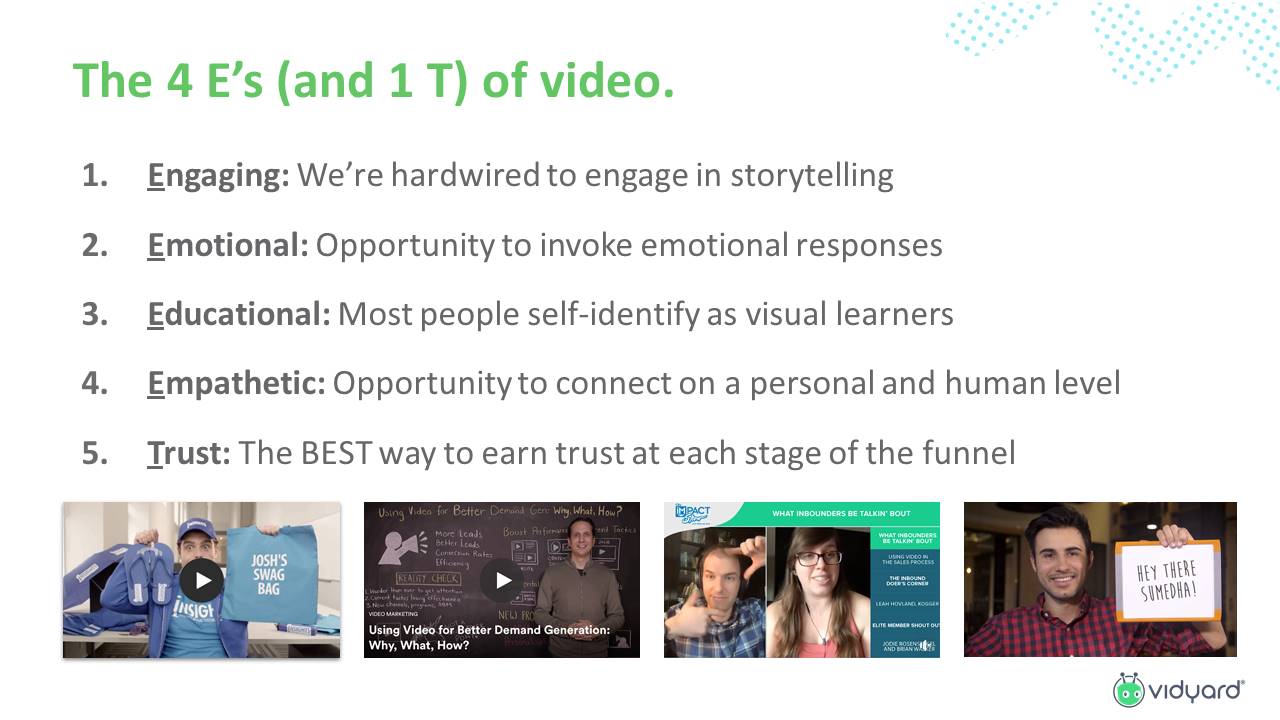
Video is a new medium that gives us richer, more engaging ways to interact with audiences. I call this the four e's of what makes videos so compelling. Video is more engaging than other content types. It's partly because we are drawn to visual information and we’re drawn to motion. We're likely to gaze five times longer at a social post that has a moving image as opposed to static text or static images and it's because our brains are hardwired to look for a motion and movement. It gives us the ability to tell bigger stories. Our brains are hardwired to engage in the storytelling narrative. Secondly, we all know video gives us the opportunity to be more emotional with our audiences. It strikes that emotional chord.
Video gives us that chance to connect on a more personal level.
- It doesn't have to be humour.
- It doesn't have to be something outrageous.
- It's about building that emotional connection
- Being more personal and building trust.
The third is video has the ability to be more educational than text-based content and I think we all understand this as consumers, but I don't think we appreciate it enough as marketers, sellers and/or business leaders. We can consume and learn more from a two-minute video than we can from reading content for 10 - 20 minutes.
“Our brain processes visual information 60,000 times faster than text.”
Our brain processes visual information 60,000 times faster than text and another important thing is we actually store visual information in our long-term memory. We store text in our short-term memories too. We are more likely to remember messages delivered to us via a visual medium. Video gives us the power to remember, which is why more and more businesses are creating two-minute explainer videos, and why they're getting on camera to explain a new product feature that they've launched. It's why a sales rep might get on camera to record a quick message to answer a question instead of typing it out via email. It's about the ability to educate and be memorable. Finally, I think the unsung heroes of video, is its ability to be empathetic, connect as real people and this is more important as we talk about a video throughout the sales and customer service sides of things.
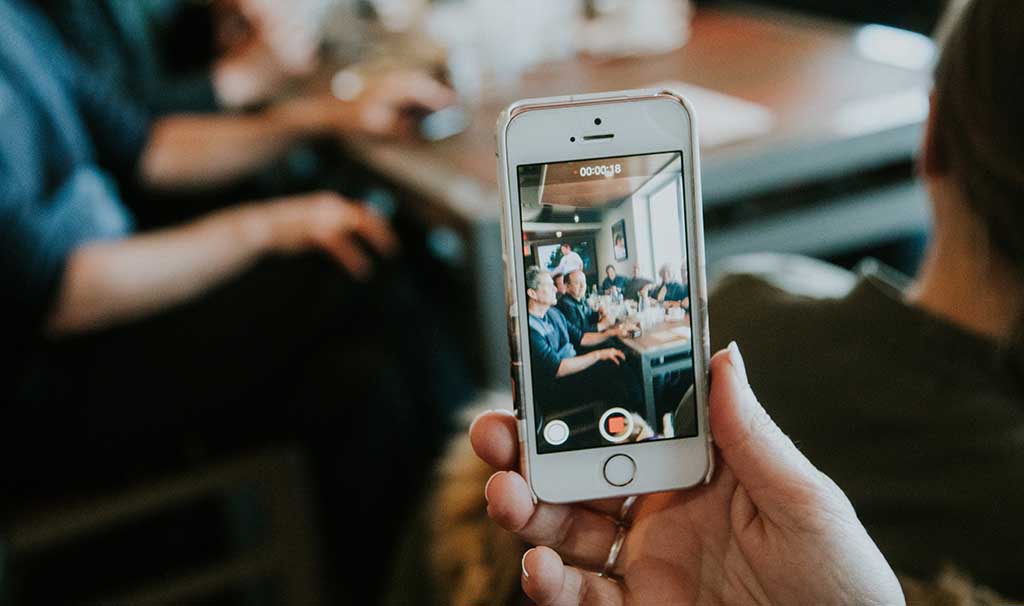
I had to sneak in a number five, which is the T, its trust and I think this is just such an important word right now. I think video is the ultimate way for us to build trust with our audiences. It's partly about putting ourselves on camera and putting ourselves out there. If you watch a video from a company where it's their real CEO, it's their real person who developed the product. You're more likely to trust that content than something that's written or something that's hidden behind the scenes.
“I love the flywheel”
The best way to engage at each stage of the flywheel, let me explain what I really mean by that. The flywheel goes around and we talk about marketing, sales, customer service and if you talk about the actions we take in the flywheel, it's about attracting, engaging, delighting. Once you've delighted customers, they will help you attract and then we will continue to engage and delight. In the context of video, one of the reasons I'm so passionate about video right now is, it helps at every stage. It's not just an attract mechanism, it's not just about YouTube, pre-roll advertisements.,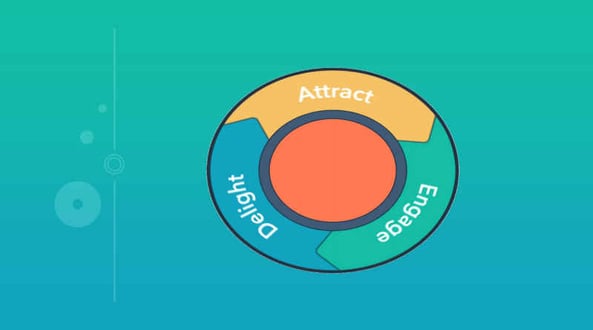
Video at the start of the flywheel can help us bring audiences into a richer inbound strategy. This is for people that are more likely to engage in a video about a topic than they are about the written word. As we move into the engage section, it gives us an opportunity to connect in a storytelling manner, in a richer way with our audiences and pull them in. Finally, in the delight stage, which is where I think video can really shine, imagine if a sales rep or a customer service rep records a quick video to share an answer with you to show you exactly how to solve a problem, that's really a delightful experience. I'm going to talk through and show you guys some real examples of what people are doing at each of these different stages to give you a sense of what you could be doing in your own business.
 All of these examples are things that you can do with a $0 budget.
All of these examples are things that you can do with a $0 budget.
What do I need to do this?
- You just need a little bit of courage.
- You need a little bit of motivation
- Start to learn the tools to create videos.
We got to get over that hurdle of thinking, I can write something, or I can do this, but I can't create a video.
"We can do it".
We just need to change our thinking of what video really is. It's a conversational medium. Now for our audiences, they're not expecting the next I can't say Super Bowl commercial or the next big World Cup commercial. They're expecting information and content in a different way. If we think about video as a conversational medium, it changes how we create changes, what we create, and it means all of us can do it.
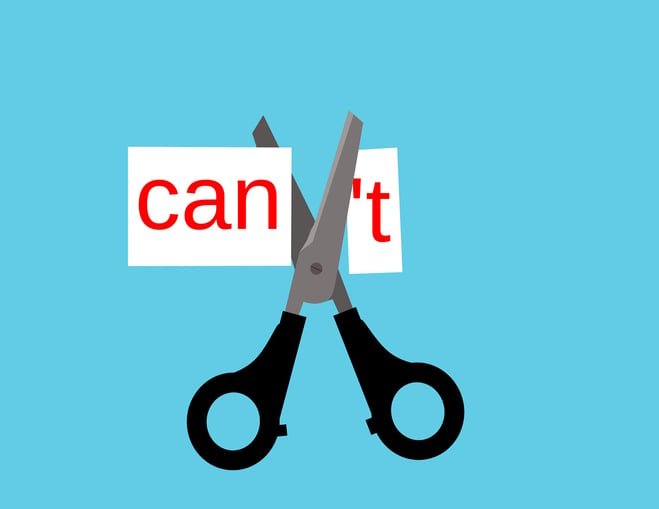
I'm going to go through at the bottom here, we've got a little legend. I'm going to talk about each of these stages really quickly and show you different examples of what real people are doing. At the attract stage, this is all about creating content that is of course going to bring audiences in as part of your inbound strategy.
Like any inbound content strategy. This is about answering the questions your audience is asking and it is no more complicated than that. How many of you here have videos that clearly explained the answer to the top 5 to 10 questions your audience has asked every day? It's really simple, you probably have blog posts that do that right? You think about SEO and blogs and what people are searching for? I've got a blog to answer that question.
- Do you have a video to answer that question?
- Is that video on your website, on your blog?
- Is it on your YouTube Channel?
- Are you leveraging social to get it out there?
- Is it a new inbound tactic for you?
It can be and it doesn't take much to create that content. The kinds of content we see at this level, this is one example from our own team.
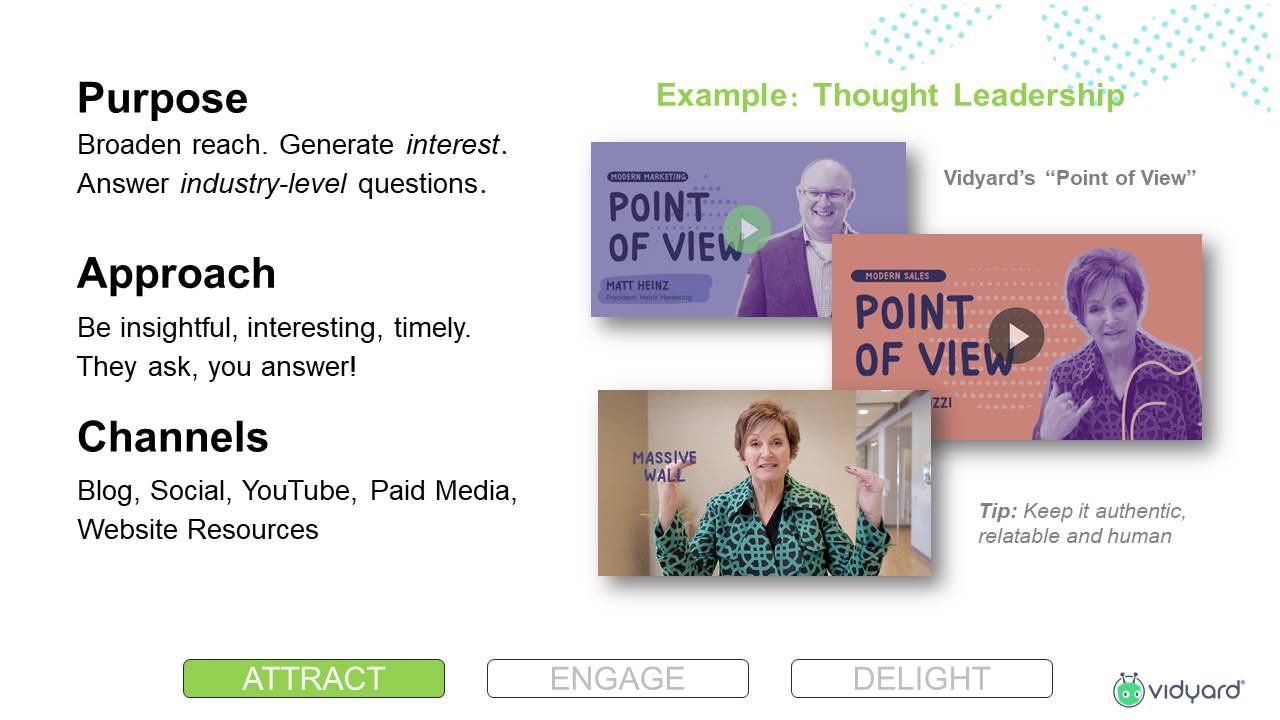
We create a few different video series. You start creating these little series to make them reproducible content that's efficient and effective. We do a series called Point of View where we interview different thought leaders in the market about different questions the industry is asking and we get their take on those. We put those out there on social and we put them out there on our blog. We transcribe the audio for the text portion of our blog posts and those become hero assets for us. They go into our nurture programs and they're great ways to answer industry questions. A company that I think does this incredibly well is a company called River Pools in the United States. They're an organisation that I've done some work with and there focus as a pool company is on answering the questions. Everybody is asking about pools. If you've ever tried to research and put in a pool, there's simple questions you're always going to ask. What's the pros and cons of fibre-glass versus concrete? What are some of the problems to expect in different kinds? How much does a pool cost?
They created videos to answer those questions authentically and transparently, even if the answers don't align back to what they do as a business. They may only do fibre-glass pools and yet they'll talk about the benefits of a concrete pool because that's how they earn trust in the market and how they build an audience. If you end up deciding to buy a concrete pool, you're going to go somewhere else. But when you decide to buy a fibre-glass pool because there's so much great information there, you're going to go to these guys and there's a great story behind how they have grown their business.
“Turn on the camera, put up a whiteboard behind you and answer questions and talk about a topic.”
They started as a local pool company and within three to four years through their inbound and then video strategy, they now have distributors all across the United States and are a massive organisation now with customers everywhere. Turn on the camera, put up a whiteboard behind you and answer questions and talk about a topic. We do that, we just tend use a chalkboard instead of a Whiteboard but I do a series called Chalk Talks where we look at the key questions our audiences asking and we do them in a visual format where we talk about a different topic. We show and walk through how to develop a video strategy and we walk through the different components of a video strategy. Do we have a guide or an eBook on developing a video strategy?
We had and that was the first thing we did. We did this video as another way to deliver that message with a lot of the same content but in a visual and distilled format. You can watch that video in about eight minutes or you can read the full guide and it will probably take you about 30 - 45 minutes. The amount of content is generally the same and it's up to people to choose what they want to engage with. Another great example is an organisation called, Gordian, and this is my favourite example of a company who just got really smart about how they productised this content. In their market, their audience asks this big question, what is job order contracting? They're in the construction software business and services and don't worry about what job order contracting is. It doesn't matter for any of us.

Think about that one big question your audience asks, and we've got great blog posts on this but they then decided to create a four-part video series that specifically answered what is job order contracting? Instead of just putting it out on YouTube, they create a gated landing page on their own website with related assets and ways to convert audiences. They also go out and promote this content very heavily in the market. They drive people to their dedicated landing page and they actually have it gated, so they can use it as a new lead generation tool. As somebody watches the video, the four videos, guess what happens? They're tracking behind the scenes and knowing that because somebody filled out the form, how long did that person watch each of those four videos?

If somebody only watched the first one 10 seconds and then bailed, they're going to go into some kind of nurture stream. If they watched all four of those videos all the way through to the end, guess what's going to happen? They're going to get a phone call from a sales rep because they know that that person is engaged. They're showing interest and intent and they can convert that person quickly. A really smart way and how they productised it and is to offer related content. At the end of each video, they have the opportunity to download a related guide or a checklist. It's a great way of also productising other assets. It was responsible for more than $6 million in new revenue in six months, which was massive. They do really big deals.
I think there was about 10 or 11 new deals that they sourced from it, but it was all about using the inbound content, understanding who was engaging, getting in a sales conversation quickly to move that deal faster. The smart way to create and to productise that content. They just did it all in house. The videos themselves aren't anything special. It was how they put it out into market and that really was the big win for them. The final thing at the attract stage is for those of you who do digital advertising are thinking more about how video plays a role in your digital advertising strategy. This might be YouTube, pre-roll videos and it may be other ads you're doing that send them to a page where there's a video to explain the topic that they've expressed interest in.
Whether you're spending money on digital ads or whether you're creating organic content at this stage, I really want you to focus on answering those questions your audience is asking. Then productising that content in different ways on your own website, on your YouTube channel, if you have one, if you don't, maybe let's get one going. You can get that content out there and it's a new source of traffic for you as well as using it across social and other avenues.
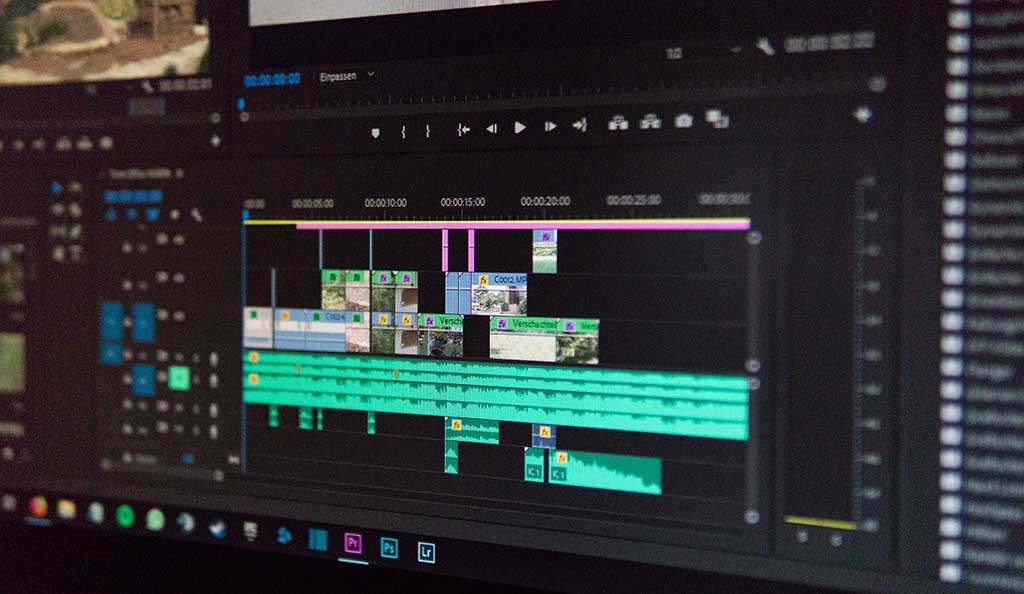
Switching gears into the engage side of things. So we've got people in, people are starting to get familiar with us, they are in our buyer's journey now and we're starting to deliver that ongoing experience to them. At the engagement stage is where you want to use authentic content to help educate your buyers to generate demand for what you do. This is no different than your broader content strategy, but now you're going to want to put that video lens on it and think to yourself, if somebody wants to learn about us through video, can they do that today? Can they take that step? or am I forcing them to read a bunch of bullet points to download a guide or a fact sheet, or to talk to a sales rep? In my opinion, somebody should be able to learn all they need to learn about your solution by going on a sit back or lean back kind of video experience. That's the end goal.
“If you don't have a short explainer video on your website, this is a great place to start.”
You can't do it all at once but think about how you chip away at that. There are simple things you're going to want to do here, like having your typical explainer video. This is your two-minute explainer that clearly articulates the problem you solve and a starting point for how you solve it. If you don't have a short explainer video on your website, this is a great place to start. If you go to your own website, take off your own business hat and pretend you're somebody else coming there for the first time. Is there a short video clearly explaining what you do? If not, it might be a good place to start because it's also an asset that would typically get used by your sales team and by your marketing team in other ways.

Other types of content we see people doing at this level, is one step deeper. For example, if you're a product company, somebody comes to your website and is requesting the demo, talking to sales and booking a meeting, these are all the main calls to action.
“What about watch a demo?”
What if, somebody who's watched your explainer video, they show they are interested, instead of trying and pushing them to talk to a sales rep or book of meeting, what if you had that simple call to action to watch a demo or see it in action or learn more? We started doing this on our own website and I've seen a lot of other companies doing it. Every time really shouldn't be a surprise to anybody here the conversion rates on people clicking watch a demo in comparison to booking a meeting are astronomically higher. If you have the right content behind it, the conversions downstream can end up giving you a big win on the back end of it. After somebody who's watched that demo, if they're showing interest and intent, and especially if you're tracking that on the back end, you're able to follow up and move them through that buyer's journey. If they can't watch a demo, this is part of the friction free process. If somebody can't see your solution and action or you company in action, they're going to go to somebody else who does. We've felt this, people who have come to our website and I've talked to people, they have gone to one of our competitor's websites where they can watch a demo, they can sign up for free and get started and they never come back to us.
That's a problem that we've started to solve ourselves and I think many of us can do this as well. Things like simple customer stories or something else you want to think about when using video today. Getting many of us to write case studies and testimonials but unfortunately those things don't bring out the real passion and humanity in your customers. If you're doing this, I would encourage you to think about a customer story, not a customer testimonial. I mean the testimonial is great and a case study is great, but what I encourage you to think about with video is, how do you bring their story to life? How do you pull out that human part of their story? Get them talking honestly on camera about why it is that they invested and what it meant for them personally in their careers, how you've genuinely helped them. Try to stay away from 80% increase, click through rates, keep the buzz out of it and just make it authentic. That resonates much better today than other types of content.
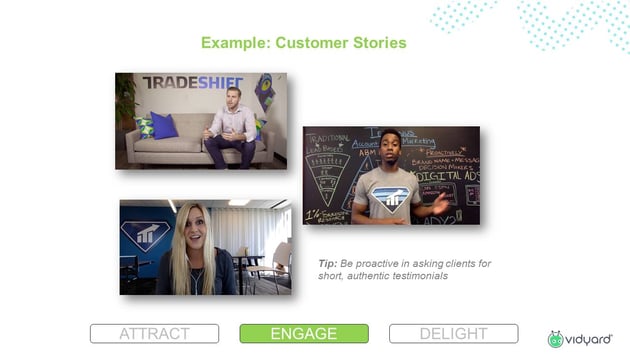
The third one, which is what I'm really excited about to see more and more happening, is sales and service, which has a big part to play in engagement as well. They're not just about delight. As we talked about earlier, sales is part of the buying process and more sales reps and service reps are using one-to-one videos as a way to engage their audiences in this richer way. The old world was either in the old, old world where you would book a call or get a call from a salesperson and you would then talk over the phone. We then went to this world where everything went online and everything happens over email. They request something, maybe something happens, but this whole conversation happens over email and the problem there is we've kind of disinter-mediated the sales rep as a real person and the humanity of them.
What we're seeing people now do is video calls and conference calls. If you're having a call with a customer, you encourage them to hop on a zoom, because you have the ability to actually do body language and connect more personally. Talk about the weather, sports or whatever it is that you want to do, because it’s important to building that relationship and establishing trust. You can't always do a video conference call so:
- What about when that customer is showing interest and you now want to respond to them?
- You want to reach out to somebody to revive that dead deal
- Somebody who has been moving along in the sales process and they have gone dark.
- How do you get them back?
Record and send a quick video message to put yourself on camera, make video and asynchronous medium and this is happening more and more. I'll show you exactly how you can do this in HubSpot today. For those of you who aren't doing it yet, HubSpot’s actually built this into HubSpot video so sales reps can just click, record, send the video off and engage their audience through that way instead of typing out an email.
“Just because you have the answer in written word doesn't mean that you're delivering the best possible experience.”
There are a few different ideas about using video through that attract and engage stages as we now move through to delight. I think there's a number of things we're starting to see people do here and with video in that post sale fashion, we will focus on for delight. As somebody becomes a customer of yours in a part of your business, depending on what you offer, it might make sense to welcome them through a fun personal video. Do you have great video-based articles in your knowledge base or answers to the common questions your customers have so they can find it and engage with it? More people visit YouTube to find out how do they do something or how do they fix this? It's because they expect a short video that's going to show them how to answer that. If you're sending somebody over to your support and service centre, your knowledge base, they will have to read through text-based articles and it might be fine. It might work but imagine the level up, in terms of the experience. When you're putting short videos to clearly show them things, you're delivering the content the way they expect it and they want it as consumers that's something else to think about. Just because you have the answer in written word doesn't mean that you're delivering the best possible experience.
There's lots of other fun things you can do and this stuff I've found personally goes a long way in managing those relationships when we're in this digital age with customers. Things like happy holidays, videos and messages. How many people actually received them from vendors at holiday time? How many of you open them up and you're enthralled with it? You're passing it around the office shouting “they wished me a happy holiday”?. No, you don't look forward the email thinking they care about me. Sometimes if you do it right, it's an opportunity to be a bit more personal, to build a connection and something as simple as getting your whole company on camera recording a genuine happy holiday, great to have you part of the family can go a long way.
In fact, I have an example here that I want to quickly show you which is the one of the most successful videos my team has done. Not just from an engagement perspective but from an actual influence on revenue and pipeline. This is our happy holidays video from a couple of years ago. And this is the thumbnail image of the video that would have shown up in your inbox. You can see written in the skies. Thanks for a great year.
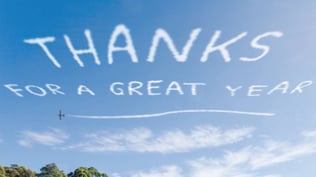

I'm off the status we've won already because it was amazing video. You mean a lot to us and this year my company really wanted to show you our appreciation. We all got together and said, let's go big. Let's go sky high, let's go for the dazzle turned into a company-wide event sales. Some were even a little upset, even the operations team got into the spirit. In fact, with so many great ideas, when I began to worry that my gesture was too small, too insignificant or feared, that my humble message would only get lost in the spectacle of commotion of so much razzle dazzle. Then I remembered I live next to an airfield.
These were some of the legitimate responses we got back. I just want to share this because this was like the day our marketing team won the Internet and you've got to share those moments. You get responses like,
- “This is hands down one on favourite emails ever”.
- They actually took the time to spell it out, which is amazing.
- I know this might be the greatest Christmas present I received this year.
- I'll take a meeting to find out more
It's pretty sad for them, but great for us. There was no ask for a meeting in any of this. I just want to share with you because this is the opportunity with video at that far end of the spectrum this was a true delight moment for our audience. We have tech in Vidyard to do automated personalisation like that.
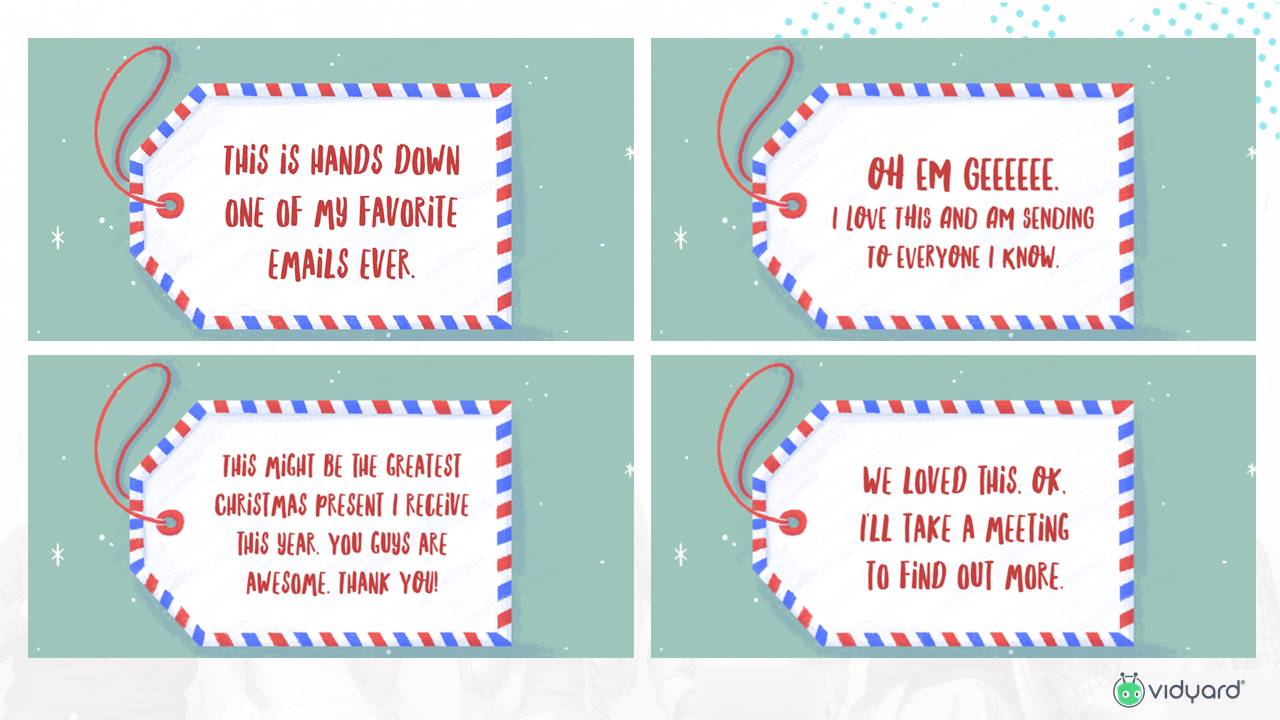
Everybody gets a version of that video with their own name in it. We get to cheat and we get to use our own tech to do it at scale. This is an example of how we can level it up because nobody's responding like that to the typical card or the typical happy holidays email with the little dancing reindeer on it. They're just not! This is the opportunity with video to re-think things. I talked about using video and customer service and this is the opportunity we see in sales to get on camera, to communicate with your audiences directly and deliver them a bigger experience. I just want to take a few minutes now to show you how you guys can do some of this stuff and deliver this through what HubSpot has done with HubSpot video and actually start to do this today.
If you're not a HubSpot, a professional or enterprise user, shame on you! First of all, I will show you how you can do some of this without that. Let's take the marketing side first. You've created a great video A bit similar to a little chalk talk, a whiteboard video, a little how to video with HubSpot video and for those of you who have not used it yet again, it is integrated as part of Professional and Enterprise marketing hub. It's a really simple process how to simply upload your videos, publish them and start to optimise them. Right inside of HubSpot you can now upload the video directly into the file manager by clicking on the add video button and you simply upload the video into the system and you can then add a call to action to the end of your video.
Ending your video
How do you want the video to end? You can have a button or any kind of call to action that you want. It's integrated with the core HubSpot CTA and you can actually leverage ones that you've already built and those will become the CTA at the end of your video. You also have the ability to brand the playback experience and it will be your own player colours and look like a native video on your website that's part of your own brand. Once the video is up there you can now publish it on any HubSpot landing page and get it up on your site, blog or wherever it needs to go and that video is now live and running. The benefit of doing something like this over uploading it to YouTube and embedding the YouTube version is you've got a lot more control in the experience here.
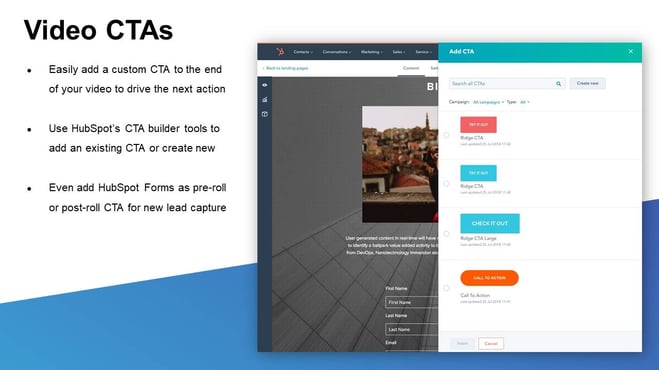
You can brand the player for your own playback experience. You can customise the call to action. There's no chance somebody's going to click on that little YouTube button in the corner and be off watching cat videos the rest of the day. You've done it before and you're going to get much richer analytics back right inside of HubSpot. As people are watching that video, right inside of the analytics on the page, you're going to see number of video views and the average retention rate of you have people watching that video. All of that data is going to be right there inside of HubSpot. Just like where you consume information about your other content types, it's great and gives you base level of functionality.
The second side of it is video inside of sales and service hubs. Let me quickly show you what that's all about. Let's say I'm a sales rep and I want to reach out to a customer to follow up on a lead that's come in or maybe I want to reach out to recap a call we just had or maybe I want to send them a contract or a purchase request. I want to instead record a quick video as part of that email to them, what you can do now is use the insert video button. It is just like an attachment. I can click on that to add a video to this outbound email and when I click, I have the option to record a new video using my webcam.
“The magic of it is, you not dealing with MP4 files”
I can record a screen capture video or upload another video I've already recorded. I can access my library of other videos that are already uploaded into HubSpot. I want to send them one of my marketing videos or I want to record a new one. Let's say I select to record a new camera video or a screen capture, it quickly records count down three, two, one and then I record my video. Once I stop, the thumbnail image gets dropped into your email and you send it off. The magic of it is you not dealing with MP4 files. You don't have to take this video and upload it somewhere and figuring out what to do with it. As soon as you've recorded that video, it's ready to go on its own page in the cloud and you send it off.
That thumbnail image has a nice play button over top of it and somebody clicks to play it. They will then go to that page and watch that quick video. It's all about being simple and easy. I'm a marketer, so I'm going to say this so easy, even a salesperson can do it. I know I'm going to get some lash back on that one but that's the point that it's so simple. It's not like I'm going into QuickTime and hitting record and then I save the file and then I upload it to YouTube and it’s just as unnatural hurdles. It's just like going to Facebook, hitting record and posting it. We're seeing people use this in lots of different ways and I think that's the most important thing here is the process to do it is simple, but you've got to figure out how it works for you.

If you're doing outbound selling, maybe it's a great way to cut through the noise and instead of sending the same old templated text based email to every prospect, you're recording a short video. Maybe you're putting their name on a whiteboard or you're pulling up their website and a screen capture to show them this is just for them and it's a more engaging experience. I will almost guarantee you that you will get a higher click through and response rates to those. New leads come in, instead of just following up with a text-based email, record a quick video to introduce yourself.
It humanises the process and introduces yourself as you go through the customer life cycle. Right after you've had a meeting, a follow up email where you're going to be putting all those bullet points of everything you agreed to, hit record the record button, talk about it, list it out and then send it over. It not only gives the information in a concise way, but it keeps that human element going and there's lots of other ways you can use it. It's another great way to communicate your message but in a way that brings the humanity into it and drives a more engaging experience.
Why not start today?
All this stuff is ready to go today. If you're not using it yet today, I encourage you to start trying this out again in Hubspot Professional or Enterprise. All the basic capability is in the platform however, outside of HubSpot there's also a free version of Vidyard go video, which is the tool that's being used to record and send those custom videos. You can just get that as a chrome extension as well.
Whether you're using HubSpot or not, you can start using that. It's free, it's simple and you could start recording, sending video messages and screen captures as much as you want. It's a great way to start to get that experience with getting on camera and using the content.
Feel free to email me if you've got any questions about some of the things that we talked about here.
Resources
- The Flywheel Model
- Customer Experience – A guide to customer satisfaction
- Ebook – Tips for a Successful Inbound Strategy
- The Power of Visual Storytelling: 15 Stunning Examples to Inspire You
- Social Media
- The benefits of blogging for business
- Creating Tracking URLs
- The Ultimate guide to Digital Marketing
- Vidyard

